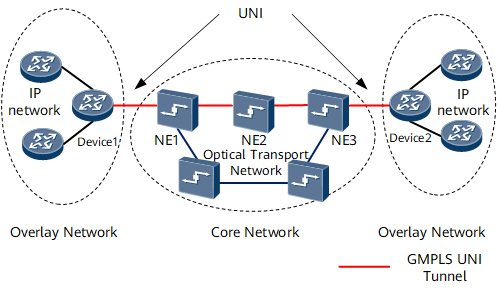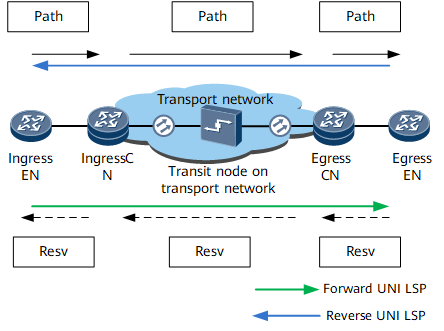Establishment of a GMPLS UNI Tunnel
Establishment of a GMPLS UNI Tunnel
In the GMPLS UNI model, an IP network and a transport network are managed in two separate domains, between which routing information and topology information are not shared. Therefore, explicit paths need to be established to specify data transmission paths, and signaling packets transmitted over the transport network need to be encrypted and authenticated. The specific measures involve static configuration of the Link Management Protocol (LMP) between the ingress EN and the source CN and establishment of UNI LSPs using the Resource Reservation Protocol-Traffic Engineering (RSVP-TE).
Bidirectional UNI LSP
On a traditional MPLS network, two unidirectional LSPs need to be established to set up a bidirectional LSP. This configuration, however, causes many problems, such as long delay and high cost in setting up the bidirectional LSP, and low reliability and complicated management of the bidirectional LSP.
GMPLS supports the establishment of bidirectional UNI LSPs in symmetric mode with a unified TE requirement (resource sharing in either directional, path protection and recovery, LSR and resource requirement), unique ingress node and egress node, and unique signaling information. Therefore, the delay and cost in establishing a bidirectional UNI LSP is greatly reduced and the preceding issues are properly addressed.
After a GMPLS UNI tunnel is configured on an ingress EN, a label of the reverse UNI LSP is assigned to the ingress EN and the label is sent to the ingress CN in a Path message. Note that assigning a label of the reverse UNI LSP to a node means to reserve bandwidth resources for the reverse UNI LSP on the node.
After receiving the Path message from the ingress EN, the ingress CN creates a bidirectional FA tunnel to the egress CN. Then a label of the reverse UNI LSP is assigned to the ingress CN and the label is sent to the egress CN in a Path message.
After the Path message reaches the ingress CN, a label of the reverse UNI LSP is assigned to the egress CN and the label is sent to the egress EN in a Path message.
After receiving the Path message from the egress CN, the egress EN reserves bandwidth resources for both the reverse UNI LSP and the forward UNI LSP based on RSVP, and labels of both UNI LSPs are assigned to the egress EN. Then the egress EN creates a Resv message and sends the message to the egress CN.
After the Resv message reaches the egress CN, a label of the forward UNI LSP is assigned to the egress CN and the label is sent to the ingress CN in a Resv message through the FA tunnel.
After the Resv message reaches the ingress CN, a label of the forward UNI LSP is assigned to the ingress CN and the label is sent to the ingress EN in a Resv message.
After the Resv message reaches the ingress EN, a label of the forward UNI LSP is assigned to the ingress EN.
In this manner, each node is informed of the forward/reverse UNI LSP label of the adjacent node and a bidirectional UNI LSP is then successfully set up.

